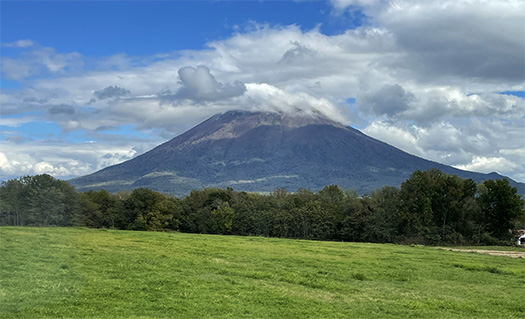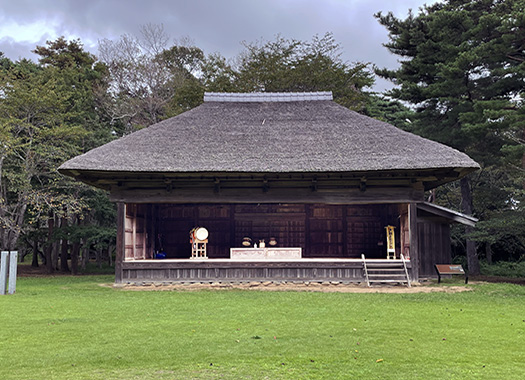

本日から1週間、札幌から仙台、東京と移動出張ウィーク。
ずいぶんたくさんの移動を経験してきたけれど、
わたしの父親やその先の先祖の事跡をたどることが時々あって、その結果、
どっちかというと農民的定置生活よりも、移動交流型の印象が濃い。
血は争えないのかなぁと時々思うことがある(笑)。
移動するとそれぞれの地域で違った風景体験を得る。
日本人の風景体験でやはりいちばん大きいのは富士山のような
独立型火山に対する「山岳信仰」に根ざした美意識ではないだろうか。
上の写真は北海道のニセコ地域の象徴、羊蹄山。
周辺地域のなかで一種独特の立ち位置にあり、地域のシンボル。
天智帝期の武官・地方豪族、阿倍比羅夫による北海道進攻に際して地名として
「後方羊蹄」という漢字記述で「シリベシ」と読ませることが
日本史初見として歴史舞台に登場する。
ヤマト政権側の正史記録でもこの羊蹄山に対しての独特な感覚が読み取れる。
語彙的には後方という部分を人体の「シリ」と婉曲表現したとされるけれど、
だったら、どうして「ベシ」で羊蹄になるのか腑に落ちない。
語源としてアイヌ地名があったのかどうか・・・。
が、日本人には西蝦夷地を象徴する山岳地形としての記憶刷り込みになった。
いま、現代多くの欧米人、アジア人を惹き付けている当地の魅力のなかで
この独特の独立火山の美感も与っているに違いないと思っている。
富士山によく似た感じの山岳として、岩木山以北では日本ではこれなのだろう。
一方で、日本の建築では多雨気候への対応として
屋根の美感が追究されてきたのではないかと思っています。
下の写真は以前見た「房総の村」での農村舞台。
広場に観衆が座って、この舞台の上で祭礼時などに芸能が挙行され
都から流行の空気感を伝える舞台文化が拡散されていった。
しかしそれ以上に、舞台という「見せる空間」として水平方向の広がりが追究された。
この舞台建築ではたぶん6間幅で左右空間を「飛ばして」いる。
柱を省略して水平感が強調される印象。
構造補強的に野太い梁が見えている。
潜在意識的な同期性として、独立火山地形がアナロジーできる。
そこから屋根形状が建築物理と雨仕舞の検討の結果、
ふさわしい「納まり」として傾斜角度が決定されていったけれど、
そのときに独立火山のカタチが潜在意識から選択されたように思われる。
っていうか、物理にごく素直な選択が自然とも同期する、ということか。
やはり風土の中で選択された「ふつう」の感覚には
非常に高い蓋然性がそこに託されている、というように思い至っている。
English version⬇
Japanese Aesthetic Sense and Architectural “Climate
The unique place name of Yotei (Shiribeshi), which appeared in Japanese history during the expedition of Abenohirau. The Japanese reverence for independent volcanic landforms. Its far-reaching influence on architecture. …
It’s been a week of traveling from Sapporo to Sendai to Tokyo starting today.
I have been on the move a lot.
I have been on the move a lot, but sometimes I have to follow in the footsteps of my father and his ancestors, and as a result, I have a strong impression that I am more of a mobile exchange type of person.
I have the impression that I am more of a mobile person than a peasant person.
I sometimes wonder if blood is no longer blood (laughs).
When you move around, you experience different landscapes in each region.
The biggest landscape experience for Japanese people is the “mountain worship” of independent volcanoes such as Mt.
Fuji, the biggest part of Japanese people’s landscape experience is the aesthetic sense rooted in “mountain worship” toward independent volcanoes.
The photo above shows Mt. Yotei, the symbol of the Niseko area in Hokkaido.
It has a unique position among the surrounding areas and is a symbol of the region.
The name “Yotei” was written in Chinese characters as the name of a place when Abenohirau, a military commander and local powerful family, invaded Hokkaido during the reign of the Emperor Tenchi-period.
The Chinese characters used to write “backward yotei” and to read “shiribeshi” were the first time in Japanese history that the word “shiribeshi” appeared on the historical stage.
This was the first time in Japanese history that a place name was written in Chinese characters and read as “Shiribeshi”.
The Yamato regime’s authentic historical records also show a unique sense of Mt.
It is said that the word “back” was euphemized as “shiri,” the human body, but if this was the case, why was the word “beshi” used for Mt.
If this is the case, it is not clear why the word “beshi” is used for “yotei.
I am not sure if there was an Ainu place name as the origin of the word….
But the Japanese have an imprinted memory of the mountainous terrain that symbolizes the western Ezo region.
The beauty of this unique independent volcano is one of the attractions that attract many Westerners and Asians to the region today.
I believe that the beauty of this unique independent volcano must also be a contributing factor.
Fuji, this is probably the only mountain in Japan north of Mt.
On the other hand, Japanese architecture has been pursuing the aesthetics of roofs as a response to the rainy climate.
I believe that the aesthetics of roofs have been pursued.
The photo below is a rural stage at a “Boso no Mura” village I once saw.
On this stage, people sit in the plaza, and performing arts are performed during festivals and other events.
The stage culture that conveyed the atmosphere of fashion from the capital was diffused.
However, more than this, the stage, as a “space for showing,” was pursued to expand horizontally.
In this stage architecture, the left and right spaces are “skipped,” perhaps six ken wide.
The horizontal impression is emphasized by omitting the pillars.
The thick beams are visible as structural reinforcement.
As a subconscious synchronicity, one can make an analogy with the independent volcanic topography.
From there, the roof shape was determined as a result of architectural physics and rainproofing considerations.
The angle of inclination was determined as an appropriate “fit.
It seems that the shape of the free-standing volcano was selected from the subconscious at that time.
Or, rather, a very straightforward choice based on physics is also in sync with nature.
After all, the sense of “normal” selected in the climate has a very high probability
I have come to the conclusion that there is a very high probability that the sense of “normal” selected in the climate has been entrusted to it.
Posted on 10月 23rd, 2022 by 三木 奎吾
Filed under: 住宅マーケティング, 出張&旅先にて







コメントを投稿
「※誹謗中傷や、悪意のある書き込み、営利目的などのコメントを防ぐために、投稿された全てのコメントは一時的に保留されますのでご了承ください。」
You must be logged in to post a comment.